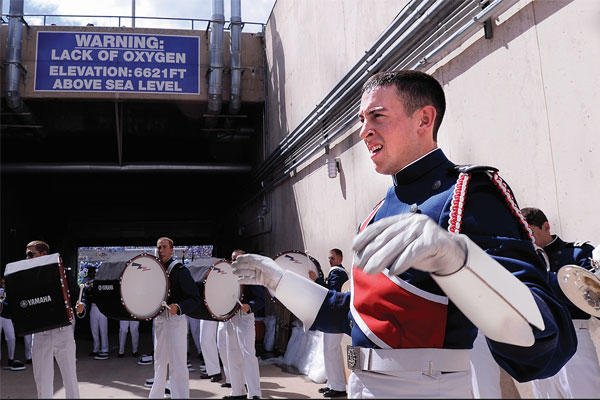U.S. AIR FORCE ACADEMY, Colo. -- A senior cadet here won an award for the best undergraduate research poster from the American Chemical Society's Division of Polymer Chemistry during the Society's national meeting in Dallas March 16-20.
Cadet 1st Class Ford Carty's poster was judged best of 31 posters, including some presented by students from California Technical University, Texas A&M, the University of Texas, the University of Akron and Penn State University.
Carty attended the 247th ACS National Meeting and Exposition along with six other cadets and presented research on a method of creating polymers that he hopes will apply to chemical weapons detection.
Carty, a native of Corales, N.M., became interested in research during his high school. In 2008, he and his brother, Vaughn, won a trip to the Intel International Science and Engineering Fair in Atlanta for their research on biofuel-producing algae. Carty said he became interested in polymer research after taking a polymers class with Dr. Scott Iacono, the Academy's Chemistry Research Center director and an instructor in the Chemistry Department.
"I really enjoyed polymers class, and I really enjoyed his style of teaching," Carty said. "(Polymers) really give you a wide range of chemistry to work with."
Polymers are large molecules made up of multiple repeating molecular chains. Many polymers, including DNA, exist naturally, while others, including most household plastics, are artificially created. Carty's research combines chains of fluorine molecules linked to hydrocarbon chains using nitrogen atoms to create a substance known as an aryl amine fluoropolymer.
The fluorine atoms make the polymer solution-processable, which means it can be dissolved in a solvent and applied as thin films or coatings according to Ford's research advisor, Dr. Iacono,. This trait is important for polymers made to be applied to electronic devices.
"This would be a relatively inexpensive product," Carty said, "something you could just wear. It would give off a signal either electronically or visibly, saying, 'Hey, this isn't a good area to be in.'"
Chemical receptors attached to the polymer at the molecular level would let equipment detect specific substances, such as VX or sarin nerve gas, Carty said.
"We have the ability to tailor the polymer to detect whatever chemical we want to detect," he said. "The ability to change functional groups (one or more atoms at a site of reactivity) is really important here, because when you change those functional groups, you can tailor the polymer to only detect certain types (of chemicals)."
Potential applications could range beyond chemical weapons detection. Carty said the polymer might also be useful to detecting harmful substances in the human body or chemicals in soil.
"Chemical detection in general is what we're after here -- just a sensor aspect," he said. "The end goal is to get all the way to detection."
Carty will begin pilot training at Vance Air Force Base, Okla., after graduation.
Also named on Carty's research are is his research advisor Iacono, Cynthia Corley, a CRC chemist, and Dr. Endrit Shurda, a National Research Council research associate in the CRC. Funding support came in part from the Air Force Office of Scientific Research and the Defense Threat Reduction Agency.






























